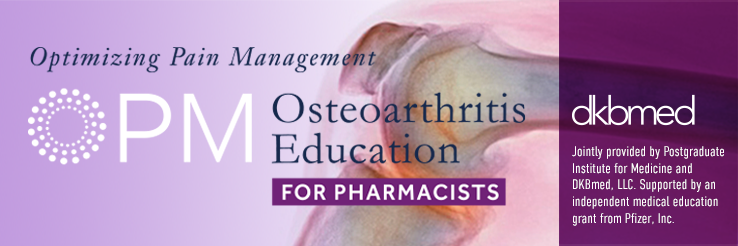
Expired activity
Please go to the PowerPak
homepage and select a course.

This educational activity is jointly provided by the Postgraduate Institute for Medicine and DKBmed, LLC. Supported by an independent educational grant from Pfizer, Inc.
FACULTY
 Robert L. Barkin, MBA, PharmD, FCP
Robert L. Barkin, MBA, PharmD, FCP
Professor, Anesthesiology
Family Medicine Pharmacology
Rush Medical School of Rush University
Chicago, Illinois
 Bill McCarberg, MD
Bill McCarberg, MD
Founder, Chronic Pain Management Program
Kaiser Permanente
Retired Adjunct Assistant Clinical Professor
University of California
San Diego, California
Disclosure of Conflicts of Interest
Postgraduate Institute for Medicine (PIM) requires faculty, planners, and others in control of educational content to disclose all their financial relationships with ineligible companies. All identified conflicts of interest (COI) are thoroughly vetted and mitigated according to PIM policy. PIM is committed to providing its learners with high quality accredited continuing education activities and related materials that promote improvements or quality in healthcare and not a specific proprietary business interest of an ineligible company.
The faculty reported the following relevant financial relationships with ineligible entities related to the educational content of this CE activity:
Robert H. Barkin, MBA, PharmD, NHA has no actual or potential conflicts of interest in relation to this program.
Bill McCarberg, MD: Consulting fees: Lilly, Scilex Averitas; Speakers’ Bureaus: Adapt, Scilex
The PIM planners and others have nothing to disclose. The DKBmed planners and others have nothing to disclose.
ACCREDITATION STATEMENT
 In support of improving patient care, this activity has been planned and implemented by the Postgraduate Institute for Medicine and DKBmed, LLC. Postgraduate Institute for Medicine is jointly accredited by the American Council for Continuing Medical Education (ACCME), and the Accreditation Council for Pharmacy Education (ACPE) and the American Nurses Credentialing Center (ANCC), to provide continuing education for the healthcare team.
In support of improving patient care, this activity has been planned and implemented by the Postgraduate Institute for Medicine and DKBmed, LLC. Postgraduate Institute for Medicine is jointly accredited by the American Council for Continuing Medical Education (ACCME), and the Accreditation Council for Pharmacy Education (ACPE) and the American Nurses Credentialing Center (ANCC), to provide continuing education for the healthcare team.
Continuing Pharmacy Education
 Postgraduate Institute for Medicine designates this continuing education activity for 1.0 contact hour(s) (1.0 CEUs) of the Accreditation Council for Pharmacy Education.
Postgraduate Institute for Medicine designates this continuing education activity for 1.0 contact hour(s) (1.0 CEUs) of the Accreditation Council for Pharmacy Education.
Universal Activity Number: JA4008162-9999-21-2721-H08-P
Type of Activity: Knowledge
Media: Internet
Fee Information: There is no fee for this educational activity.
Estimated time to complete activity: 60 minutes
Published
June 14, 2021
Expires
June 13, 2022
TARGET AUDIENCE
This accredited activity has been designed for managed care pharmacists, medical directors, pharmacy directors, pharmacy benefit managers, and other formulary decision-makers involved in the treatment decision-making process for patients with osteoarthritis.
How to Earn Credit
During the period June 14, 2021 to June 13, 2022, participants must 1) read the learning objectives and faculty disclosures; 2) study the educational activity; and 3) complete the posttest and evaluation form directly after the activity within a maximum of 60 days of participating in the activity. To answer the questions, click on your selected choice for each answer then proceed to the next question. Once completed, click on the Grade Exam button at the bottom of the page. Your posttest will automatically be graded. If you successfully complete the posttest (score of 70% or higher), your statement of participation will be made available immediately. Click on the View Statement of Participation link and print the statement for your records. If you receive a score lower than 70%, you will receive a message notifying you that you did not pass the posttest. You will have 2 opportunities to pass the posttest. To receive Credit, you must provide your date of birth and NABP number. All Credit information will be uploaded into CPE monitor within 30 days.
GOAL
To educate pharmacists with the most up-to-date information on osteoarthritis treatments and management.
EDUCATIONAL OBJECTIVES
Upon completion of this educational activity, participants should be better able to:
- Identify the burden of OA pain, including comorbidities and racial and gender disparities in treatment, and evaluate their impact on patient quality of life.
- Describe current nonpharmacologic and pharmacologic OA treatments and identify how they inadequately meet patients’ needs.
- Evaluate the nerve growth factor (NGF) pathway and how medications blocking NGF may benefit patients with OA.
- Identify benefits and risks of in-development NGF-sequestering agents for treating OA.
REQUIRED COMPUTER HARDWARE/SOFTWARE
Please ensure the computer system you plan to use meets the following minimum requirements:
- Operating System: Windows 98 or higher & Macintosh 2.2 or higher
- Internet Browser (Mac &/ Windows): Internet Explorer 6.0 or higher, Google Chrome, Safari 5.0.6 or higher, Firefox 3.0.3 or higher & Opera 5 or higher
- Broadband Internet connection: Cable, High-speed DSL & any other medium that is internet accessible
- Peripherals: Computer speakers or headphones
- Monitor Screen Resolution: 320 x 480 or higher
- Media Viewing Requirements: Adobe Reader, Microsoft PowerPoint, Flash Player & HTML5
Disclosure of Unlabeled Use
This educational activity may contain discussion of published and/or investigational uses of agents that are not indicated by the FDA. The planners of this activity do not recommend the use of any agent outside of the labeled indications. The opinions expressed in the educational activity are those of the faculty and do not necessarily represent the views of the planners. Please refer to the official prescribing information for each product for discussion of approved indications, contraindications, and warnings.
Disclaimer
Participants have an implied responsibility to use the newly acquired information to enhance patient outcomes and their own professional development. The information presented in this activity is not meant to serve as a guideline for patient management. Any procedures, medications, or other courses of diagnosis or treatment discussed or suggested in this activity should not be used by clinicians without evaluation of their patient's conditions and possible contraindications and/or dangers in use, review of any applicable manufacturer's product information, and comparison with recommendations of other authorities.